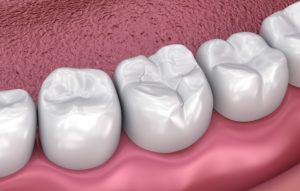 Your teeth are protected by the hardest substance in your body. Your enamel is stronger than some metals, but it isn’t indestructible. A tooth can be damaged by decay, fractures, and other issues. Dental crowns and fillings are common restorative procedures to repair teeth. They have many similarities, but there are many differences, too. Here’s what you need to know to choose the right treatment to repair your smile.
Your teeth are protected by the hardest substance in your body. Your enamel is stronger than some metals, but it isn’t indestructible. A tooth can be damaged by decay, fractures, and other issues. Dental crowns and fillings are common restorative procedures to repair teeth. They have many similarities, but there are many differences, too. Here’s what you need to know to choose the right treatment to repair your smile.
What is a Filling?
A dental filling is the go-to solution to treat decay. Traditional fillings are made using a mixture of metals, but cosmetic resin is the preferred choice among dentists and patients.
Not only is it metal and mercury free, but it is also customized to match the color of your enamel to blend in with your tooth for a seamless repair.
A tooth-colored filling is a quick and affordable solution to treat minor decay and other problems, like a chipped tooth. You’ll enjoy natural-looking results using a minimally invasive method.
Candidates for Fillings
Although fillings are a great option for many patients, they aren’t right for everyone. Generally, they are recommended if:
- You don’t have cracked teeth
- The area of decay is small
- You need minor repairs
A tooth-colored filling can last for 5 to 10 years before needing to be replaced. They are covered by dental insurance after a small co-payment.
What is a Dental Crown?
A dental crown is a cap that’s bonded over the surface of a tooth above the gum line. They can be made from many metals, but all-ceramic materials are the most popular choice because they look natural.
Your tooth is reshaped to allow the crown to fit over it, which is held in place using dental cement. They are versatile, offering preventive, restorative, and cosmetic benefits.
Candidates for Dental Crowns
Dental crowns are a bit more invasive than a feeling, so they are only recommended under certain situations, such as if:
- A tooth is cracked
- A large area of decay
- A tooth is weak
- A large break
A crown is durable and can last for 10 years or longer with the right aftercare, like brushing and flossing. They can be covered under dental insurance when medically necessary. Typically, they are covered about 50% after meeting your deductible.
Choosing a restoration for your smile is a big decision. You don’t have to make it alone. After examining your mouth to create a personalized treatment plan, your dentist will explain which option is right for you. They will discuss exactly what you can expect on the road ahead and the benefits you’ll enjoy by rehabilitating your tooth.
About Dr. Bert Tavary
Dr. Tavary earned his dental degree at the Emory University College of Dentistry and has regularly continued his education in many specialties, like cosmetic, restorative, and implant dentistry. He strives to provide family-focused dental care using the latest innovations in dentistry. Request an appointment through our website or call (904) 824-3540.
